Name Battle the | Date May 326 BC | |
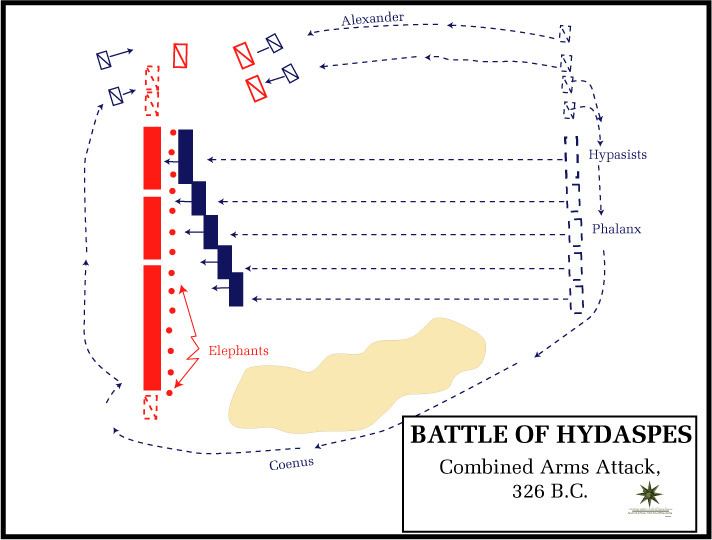 | ||
Combatants Macedonia, Achaemenid Empire, Persian Empire Similar Battle of Gaugamela, Indian campaign of Alexan, Battle of the Granicus, Battle of Issus, Battle of Chaeronea | ||
Alexander rtw historical battle of the hydaspes very hard level
The Battle of the Hydaspes was fought in 326 BC between Alexander the Great and King Porus of the Paurava kingdom on the banks of the river Jhelum (known to the Greeks as Hydaspes) in what is now the Punjab province of Pakistan. The battle resulted in a complete Greek victory and the annexation of the Punjab, which lay beyond the far easternmost confines of the already absorbed Persian empire, into the Macedonian Empire.
Contents
- Alexander rtw historical battle of the hydaspes very hard level
- Alexander the great battle of the hydaspes 326 bc
- Location
- Background
- Motives
- Pre battle maneuvers
- Battle
- Aftermath and legacy
- References
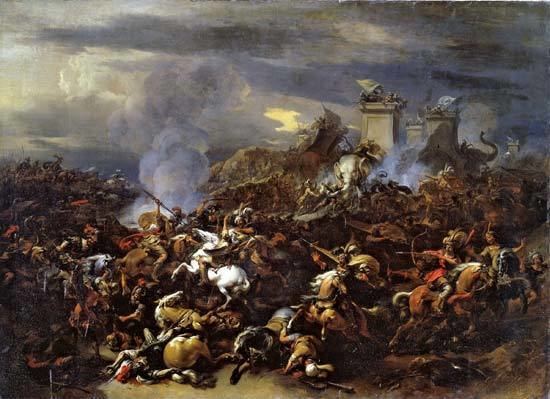
Alexander's decision to cross the monsoon-swollen river despite close Indian surveillance, in order to catch Porus' army in the flank, has been referred as one of his "masterpieces". Although victorious, it was also the most costly battle fought by the Macedonians. The resistance put up by King Porus and his men won the respect of Alexander, who asked Porus to become one of his satraps.
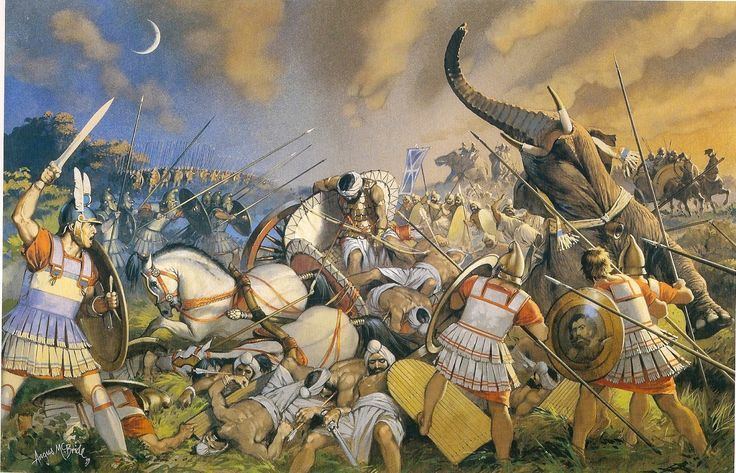
The battle is historically significant for opening up India to Greek political (Seleucid, Greco-Bactrian, Indo-Greek) and cultural influences (Greco-Buddhist art), which continued to have an impact for many centuries.
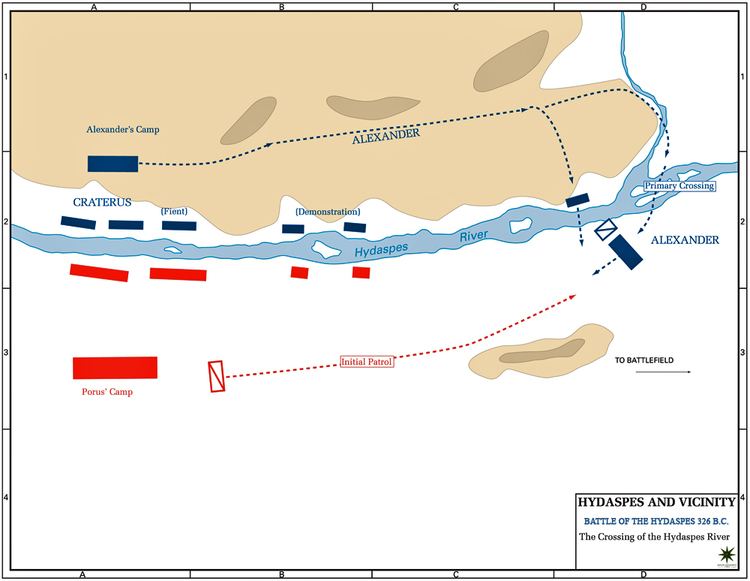
Alexander the great battle of the hydaspes 326 bc
Location
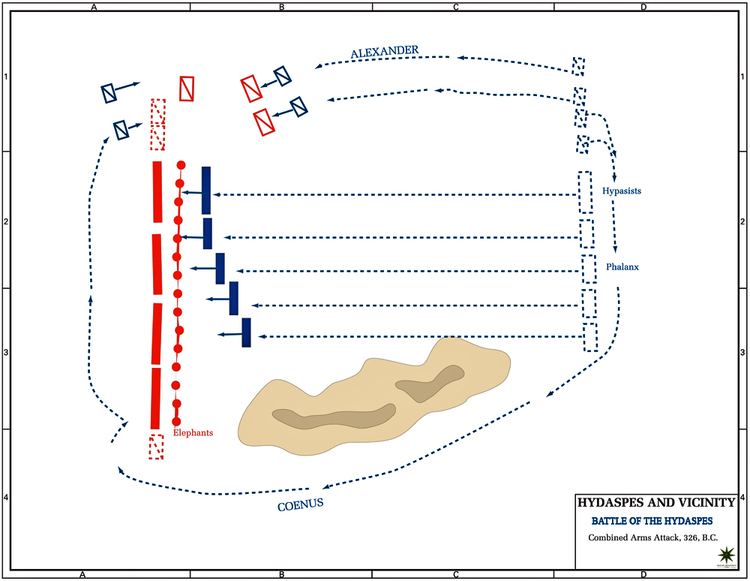
The battle took place on the east bank of the Hydaspes River (now called the Jhelum River, a tributary of the Indus River) in what is now the Punjab Province of Pakistan. Alexander later founded the city of Nicaea on the site; this city has yet to be discovered. Any attempt to find the ancient battle site is complicated by considerable changes to the landscape over time. For the moment, the most plausible location is just south of the city of Jhelum, where the ancient main road crossed the river and where a Buddhist source mentions a city that may be Nicaea. The identification of the battle site near modern Jalalpur/Haranpur is certainly erroneous, as the river (in ancient times) meandered far from these cities.
Background
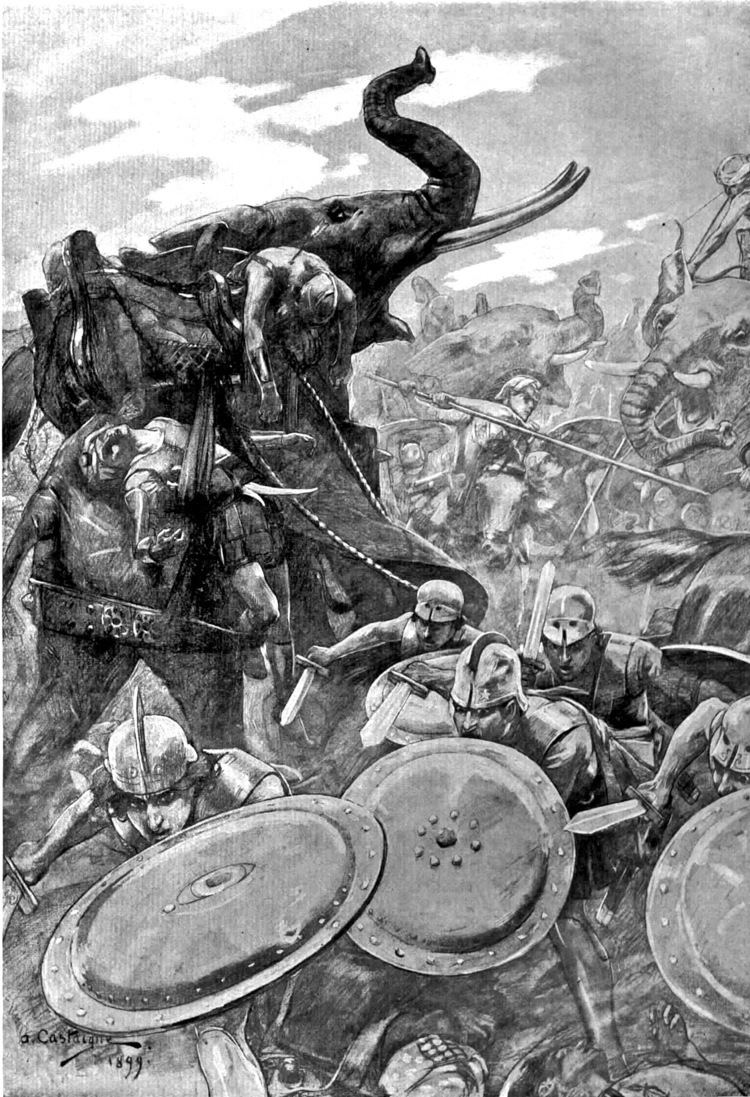
After Alexander defeated the last of the Achaemenid Empire's forces under Bessus and Spitamenes in 328 BC, he began a new campaign to further extend his empire towards India in 327 BC. Whilst possessing a much larger army, at the battle, an estimated 40,000 infantry and 5,000 cavalry crossed the river in time to engage the enemy. Depending on the source, Alexander was outnumbered somewhere between 3:1 and 5:1.
The primary Greek column entered via the Khyber Pass, but a smaller force under the personal command of Alexander went through the northern route, taking the fortress of Aornos (modern-day Pir-Sar) along the way—a place of mythological significance to the Greeks as, according to legend, Herakles had failed to occupy it when he campaigned to India.
In early spring of the next year, he combined his forces and allied with Taxiles (also Ambhi), the King of Taxila, against Taxiles' neighbor, the King of Hydaspes.
Motives
Alexander had to subdue King Porus in order to keep marching east. To leave such a strong opponent at his flanks would endanger any further exploit. He could also not afford to show any weakness if he wanted to keep the loyalty of the already subdued Indian princes. Porus had to defend his kingdom and chose the perfect spot to check Alexander's advance. Although he lost the battle, he became the most successful recorded opponent of Alexander. According to Peter Green, King Porus's performance in the battled out-classed both Memnon of Rhodes and Spitamenes.
Pre-battle maneuvers
Alexander fixed his camp in the vicinity of the town of Jhelum on the right banks of the river. Porus drew up on the south bank of the Jhelum River to repel any crossing in the spring of 326 BC. The Jhelum River was deep and fast enough that any opposition to a crossing would probably doom the attacking force. Alexander knew that a direct approach had little chance of success and tried to find alternative fords. He moved his mounted troops up and down the river bank each night while Porus shadowed him. Eventually, Alexander used a suitable crossing, about 27 km (17 mi) upstream of his camp. While leading his troops across, he landed on another island, causing his troops to wade across. His plan was a classic pincer maneuver. He would eventually attack Indian cavalry flanking each side of Porus' main force from the right. He left his general Craterus behind with most of the army, to make sure Porus doesn't find out about his crossing, while he crossed the river upstream with a strong contingent, consisting, according to the 2nd century Greek historian Arrian, of 6,000 on foot and 5,000 on horseback, though it is probable that it was larger. Craterus was ordered to either ford the river and attack if Porus faced Alexander with all his troops or to hold his position if Porus faced Alexander with only part of his army.
The most notable event in the present connection was Alexander's crossing of the Hydaspes in face of the Indians on the opposite bank. The complex preparations for the crossing were accomplished with the use of numerous feints and other sorts of deceptions. Porus was kept continuously on the move until he decided it was a bluff and relaxed. On every visit to the site of the crossing, Alexander made a detour inland to stay in secrecy. It was also reported that there was an Alexander look-alike who held sway in a mock royal tent near the base.
Alexander quietly moved his part of the army upstream and then traversed the river in utmost secrecy, using ‘skin floats filled with hay’ as well as ‘smaller vessels cut in half, the thirty oared galleys into three’. Furthermore, Craterus engaged in frequent feints that he may cross the river. As a result, Porus, 'no longer expecting a sudden attempt under cover of darkness, was lulled into a sense of security.' Alexander mistakenly landed on an island, but soon crossed to the other side. Porus perceived his opponent's maneuver and sent a small cavalry and chariot force under his son, also named Porus, to fight them off, hoping that he would be able to prevent his crossing. By chance a storm occurred that night which drowned the sounds of the crossing.
Alexander had already crossed the river, however, and his horse archers impeded the young Porus's cavalry. Young Porus also faced an unexpected disadvantage: his chariots were immobilized by the mud near the shore of the river. After his army was routed, young Porus was among the dead. As news reached the elder Porus, he understood that Alexander had crossed to his side of the river and hastened to face him with the best part of his army, leaving behind a small detachment to disrupt the landing of Craterus' force should he attempt to cross the river.
Battle
When King Porus reached the point where Alexander's army was arrayed, led to believe that his own cavalry outnumbered Alexander's, he ordered his cavalry to charge. The Indians were poised with cavalry on both flanks, their center comprising infantry with War Elephants which were heavily armored and were strapped on with a castle-like howdah on their back carrying a trio of archers and javelin hurlers towering among or before them in equal intervals of fifty feet to defend the vulnerable flanks. All of the War-Elephants were equipped with fire-hardened leather and quilted armor for protection while their foreheads and trunks bore steel-plates to defend against enemy arrows. The Pauravan Army itself was dressed in flamboyantly hued outfits wearing steel helmets, bright scarves and baldrics wielding axes, lances and maces. King Porus, seated atop the tallest War Elephant selected from his elephant corps, himself was not mounted on Howdah, as he wore a remarkable chain mail armor and hence had no need of the additional protection of a tower.
The Macedonian heavy infantry phalanx were outnumbered 1:5 against the Indian infantry. The Indian infantry still suffered setbacks due to the reach of the enemy's longer sarissas and being light to unarmored on the torso. Even their heavy armor-piercing bows were inaccurate because of the slippery ground, though the muddy ground was a advantage to King Porus' light infantry. The Macedonian army situated directly across from Porus' army crossed the river to directly meet the Elephants.The supposed 200 elephants prevented any frontal attack.
Alexander commenced the battle by sending his Scythian hired horse archers to shower the Indian right cavalry wing. His armored Companion Cavalry was sent to the outnumbered Indian left cavalry with him leading the charge himself. The rest of the Indian cavalry galloped to their hard pressed kinsmen on the right wing but at this moment, Coenus's cavalry contingent appeared on the Indian rear. The Indians tried to form a double phalanx, but the necessary complicated maneuvers brought even more confusion into their ranks making it easier for the Macedonian horse to conquer.
Alexander, destroying Porus' right flank circled around to Porus' left flank launching a mass attack against Porus's left flank. Alexander surmised correctly that Porus would be forced to move cavalry on the right wing across to the left. Alexander foresaw this and placed his cavalry, under the command of Coenus, opposite of them and out of sight. Their job was to break cover and follow the Indian cavalry, which forced the Indians to go forward, right into Craterus. Arrian states that 12,000 Indians and 80 elephants died in this mass pincer movement.
Porus, atop his elephant, personally led his elephant corps instead of the usual double-horse chariot used by Indian kings. The War-Elephants caused heavy losses to the phalanx, impaling many with their tusks fitted with steel spikes and heaving some before pulverizing them. Alexander commanded his Indian Contingents to end the carnage, with the light infantry which tossed javelins at the Elephants' eyes while the heavy infantry ham-stringed the Elephants with the two-sided axes and scimitars. They were eventually repulsed by the dense pikes of the phallangitai, wreaking much havoc upon their own lines. The mahouts were killed before they could kill their panicked elephants with poisoned rods. The remaining Indian cavalry fled among the elephants for protection, but the beasts were already out of control and would soon retreat exhausted from the field, leaving the rest of Porus's army encircled by the Macedonian horse and phalanx. Alexander sent his phalanx to attack the elephants, which were forced back on their own side. They boxed the Indian infantry and cavalry, many of whom were trampled to death. At this time, the phallangitai locked their shields and advanced upon the confused enemy. By this time Craterus and his force in the base camp crossed the river when the way was clear, and they conducted a chase against those who retreated.
Arrian records that in the final charge against Alexander, King Porus employed all his cavalry, 4,000 strong, all his remaining chariots, 300 in number, 200 of his elephants, and 30,000 of efficient infantry along with 2,000 men and 120 chariots detached earlier in the day under his son's charge.
After the battle fatigue started affecting the King Porus, he slowly began to retire. Throughout the battle, Alexander is said to have observed with growing admiration, the valor of King Porus and understood that he intended to be killed in combat. Hoping to save the life of this competent leader and warrior, Alexander commanded Taxiles to summon Porus for surrender. However, Porus turned indignant on the very sight of his nemesis and tossed a spear at him in furor without listening to his proposal forcing him to take flight on his steed. In such manner many other messengers, dispatched by the determined Alexander were spurned, till at last Meroes, a personal friend of Porus convinced him to listen to the message of Alexander. Overpowered by thirst, the weary Porus finally dismounted his War-Elephant and demanded water. After being refreshed, he allowed himself to be taken to Alexander. On hearing that the Indian King was approaching, Alexander himself rode out to meet him and the famous surrender meeting took place.
According to Arrian, Macedonian losses amounted to 310. However the military historian J.F.C. Fuller sees as "more realistic" the figure given by Diodorus of about 1,000, a large number for a victor, and more than Gaugamela,yet not improbable, considering the partial success of the Indian war elephants. Indian losses amounted to 23,000 according to Arrian, 12,000 dead and over 9,000 men captured according to Diodorus. The last two numbers are remarkably close, if it is assumed that Arrian added any prisoners to the total Indian casualties. Around 80 elephants were captured alive. Alexander also acquired 70 War elephants additionally due to the late arrival of reinforcements called for by King Porus after the battle was already over who readily surrendered and offered these beasts in tribute.
Two sons of Porus were killed during the battle, as well as his relative and ally, local chieftain Spitakes, and most of his chieftains.
Aftermath and legacy
When asked by Alexander how he wished to be treated, Porus replied "Treat me as a king would treat another king". Impressed, Alexander indeed treated him like a king, allowing him to retain his lands. Following the battle, Alexander founded two cities in this region, one at the spot of the battle called Nicaea (Greek for Victory) in commemoration of his success and one on the other side of the Hydaspes called Alexandria Bucephalus, to honor his faithful steed, which died soon after this battle. In 326 BC, the army of Alexander approached the boundaries of the Nanda Empire. His army, exhausted from the continuous campaigning and frightened at the prospect of facing yet another gigantic Indian army, demanded that they should return to the west. This happened at the Hyphasis (modern Beas), the exact spot being believed to be at 'Kathgarh' in Indora tehsil of Himachal Pradesh, India with nearest rail head at Pathankot, Punjab, India. Alexander finally gave in and turned south, along the Indus, securing the banks of the river as the borders of his empire.
The main reasons for the Pauravan's defeat were due to Alexander's use of tactics, and the Macedonians' superior discipline and technology. The Pauravans still used chariots which were inferior to the Greek's cavalry and phalanx. They neither had a well supported military infrastructure nor a standing army. The Pauravan infantry and cavalry were poorly armoured, lacking in metal armor, and their short swords were no match against the long spears of the Macedonians. Porus himself failed to take any initiative, mainly trying to counter his opponents moves. Greek historians agree that Porus bravely fought until the end.
During later rule of the Maurya Empire, tactician Kautilya took Hydaspes as a lesson and highlighted the need for military training before battle. The first Mauryan emperor Chandragupta maintained a standing army. The chariot corps played a marginal role in Mauryan military infrastructure.
